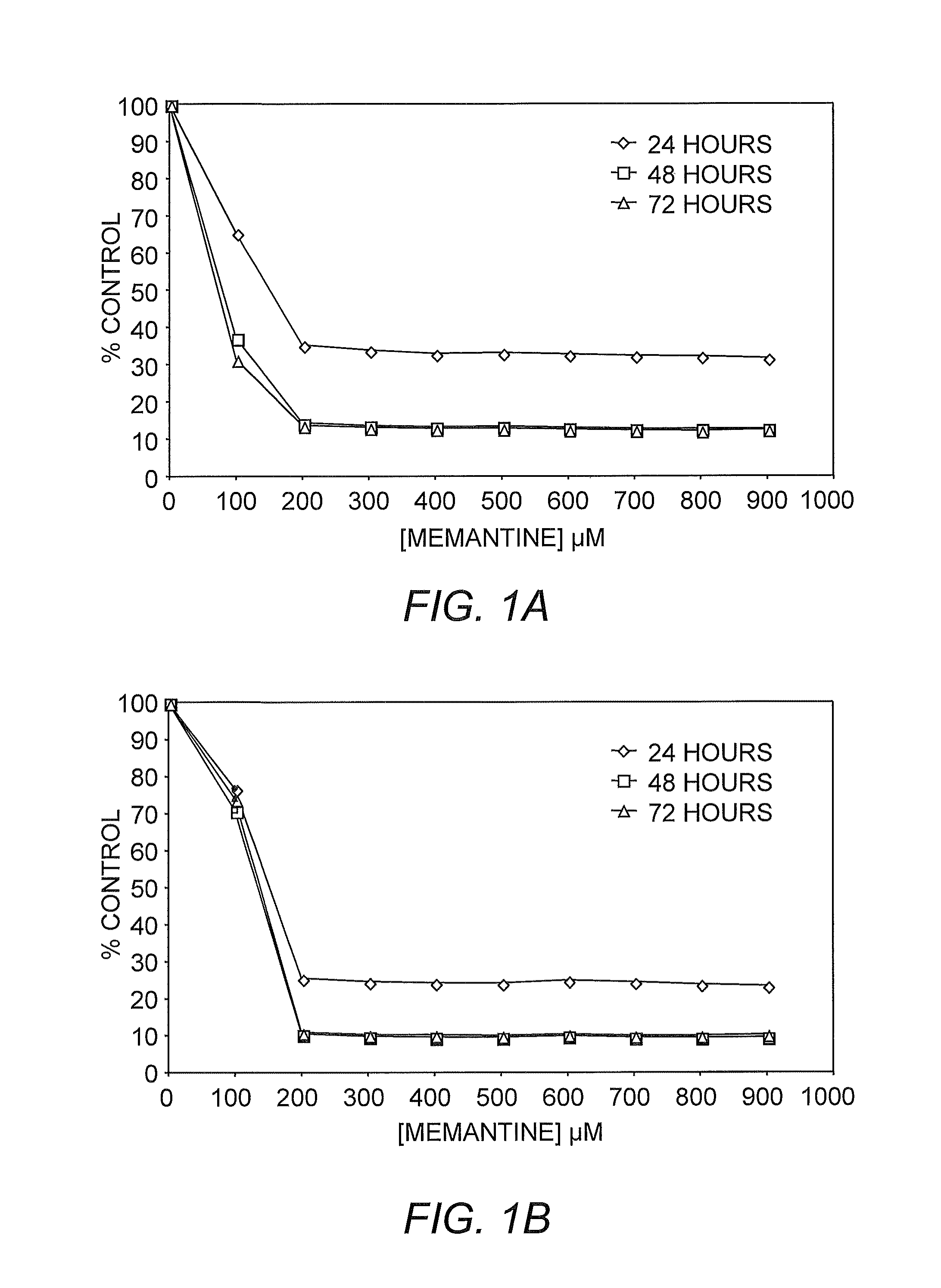Methods for diagnosing and treating neuroendocrine cancer
a neuroendocrine cancer and tumor technology, applied in the field of neuroendocrine cancer diagnosis and treatment, can solve the problems of increased cell death, decreased cell division, and toxic effects of glutamate and nmda agonists on these neuroblastoma cells, so as to inhibit or decrease the activity or expression, and reduce the proliferation of neuroendocrine tumor cells
- Summary
- Abstract
- Description
- Claims
- Application Information
AI Technical Summary
Benefits of technology
Problems solved by technology
Method used
Image
Examples
example 1
Materials and Methods
[0070]Cell Culture.
[0071]Breast cancer (i.e., MCF-7 and SKBR3) and SCLC (i.e., classical human SCLC cell lines NCI-H345, DMS-53, NCI-H146, and the variant SCLC cell line, NCI-H82) cells were maintained at 37° C. in an atmosphere of 5% CO2 using Dulbecco's Minimal Essential Medium (DMEM; 0.8 mM Mg2+, 0.4 mM glycine; Sigma, St. Louis, Mo.) or RPMI 1640 (Mediatech, Inc., Herndon, Va.) supplemented with 10% fetal bovine serum and 50 μg / mL gentamicin. Every 3-4 days, cells received fresh DMEM or were subcultured using 0.06% trypsin with 0.02% EDTA. Cell densities were at 105 to 5×105 / ml.
[0072]MCF-7 and SKBR3 are art-established cell cultures for analyzing the pathophysiology of breast cancer and preclinical analysis of drug efficacy (Hanauske (2004) Oncology (Huntingt). 18(13 Suppl 8):66-9). In particular, studies using MCF-7 cultures have correlated well with in vivo therapeutic studies. For example, Johnson, et al. ((1997) Semin Oncol. 24(1 Suppl 3):522-5) teach th...
example 2
NMDAR1 and NMDAR2 Expression in Cancer Cells
[0090]SCLC.
[0091]Analysis of the expression of the NMDA receptors by cultured SCLC cells and tumor tissues was carried out using RT-PCR of poly(A+) RNA preparations. All four SCLC cell lines tested (NCI-H345, DMS-53, NCI-H146 and NCI-H82) yielded in each case, a single overlapping product of size predicted from the structure of cDNA for human NMDAR1 from brain tissue, and reported for human LA-N-2 neuroblastoma cells (North, et al. (1997) Mol. Chem. Neuropath. 30:77-94). Cloning and nucleotide sequence analysis of these NMDA glutamate receptor RT-PCR products (488 bp and 263 bp), coding for portions of the extracellular domain, showed them to have exact sequence homology with position 208-695 of the brain and neuroblastoma receptor, and sequence identity in this portion of the NMDAR1 receptor for all four SCLC cell lines. The region in the mRNA examined represents approximately 30% of the open reading frame for the extracellular N-terminal...
example 3
In Vitro Anti-Cancer Activity of NMDAR Antagonists
[0102]Breast Cancer and SCLC.
[0103]Growth and NMDA glutamate receptor activity in cancer cells were found to respond to the effects of glutamate (NMDAR1 agonist) in the presence of glycine (NMDAR2 agonist) over 24 hours. Glutamate decreased cell growth in LAN2 cells, and increased proliferation in breast cancer cells under the conditions used (Table 1, p<0.05).
[0104]
TABLE 1Fluorescence (nm)Cell LineVehicleAgonistLAN2465420MCF7485510SKBr3345445Results represent triplicate studies performed with Alamar Blue on LAN2 neuroblastoma, MCF-7 breast cancer, and SKBr3 breast cancer cells examining the growth influence of 1 mM glutamate in the presence of glycine over 24 hours.
[0105]Treatment of these cells with magnesium (NMDAR1 antagonist) in the presence of glycine (NMDAR1 agonist) over 24 hours further indicated functional receptor activity, in that magnesium significantly inhibited proliferation of all cell types (Table 2, p<0.05).
[0106]
TA...
PUM
| Property | Measurement | Unit |
|---|---|---|
| temperature | aaaaa | aaaaa |
| concentrations | aaaaa | aaaaa |
| excitation/emission wavelengths | aaaaa | aaaaa |
Abstract
Description
Claims
Application Information
 Login to View More
Login to View More - R&D
- Intellectual Property
- Life Sciences
- Materials
- Tech Scout
- Unparalleled Data Quality
- Higher Quality Content
- 60% Fewer Hallucinations
Browse by: Latest US Patents, China's latest patents, Technical Efficacy Thesaurus, Application Domain, Technology Topic, Popular Technical Reports.
© 2025 PatSnap. All rights reserved.Legal|Privacy policy|Modern Slavery Act Transparency Statement|Sitemap|About US| Contact US: help@patsnap.com



